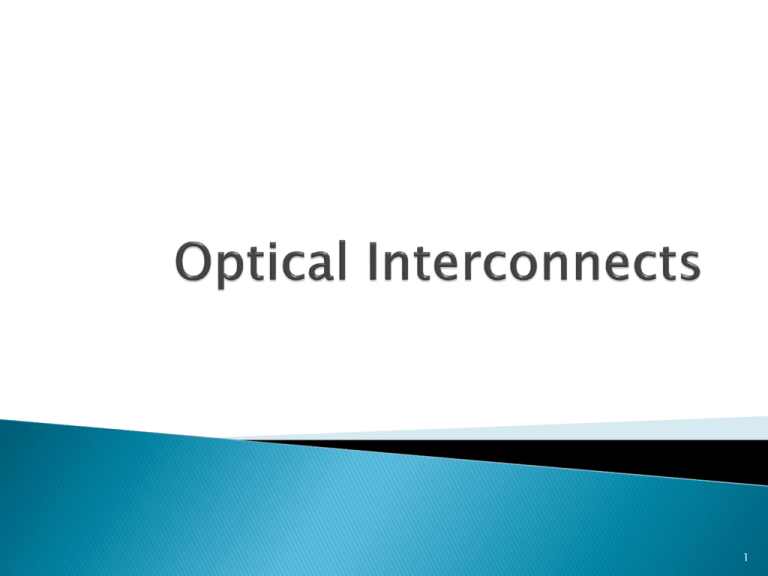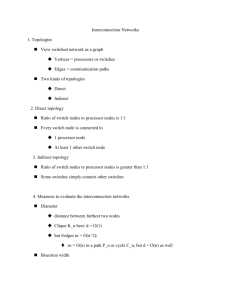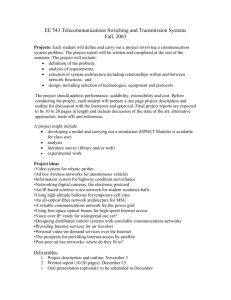Optical Interconnects: HPC
advertisement

1 Interconnection Networks ◦ Terminology, basics, examples Optical Interconnects ◦ ◦ ◦ ◦ Motivation Architecture examples for Data Centers and HPC Building blocks Sum-up - issues 2 Parallel systems need the processors, memory, and switches to be able to communicate with each other ◦ The connections between these elements define the interconnection network 3 Node Link Neighbor node Degree Message Packet ◦ Can be either processor, memory, or switch ◦ The data path between two nodes (Bundle of wires that carries a signal) ◦ Two nodes are neighbors if there is a link between them ◦ The degree of a node is the number of its neighbors ◦ Unit of transfer for network clients (e.g. cores, memory) ◦ Unit of transfer for network 4 Topology Layout and Packaging Hierarchy Routing Flow control and Switching paradigms Performance ◦ Specifies way switches are wired ◦ Affects routing, reliability, throughput, latency, building ease ◦ The nodes of a topology are mapped to packaging modules, chips, boards, and chassis, in a physical system ◦ How does a message get from source to destination ◦ Static or adaptive ◦ What do we store within the network? ◦ Entire packets, parts of packets, etc? ◦ Circuit switching vs packet switching ◦ Throughput, latency. Theoretically and via simulations 5 Direct topology and indirect topology ◦ In direct topology: every network client has a switch (or router) attached ◦ In indirect topology: some switches do not have processor chips connected to them, they only route Static topology and dynamic topology 6 Examples (Direct topologies): 6-linear array 6-ring 6-ring arranged to use short wires 2D 16-Mesh 2D 16-Torus 3D 8-Cube 7 Examples (Indirect topologies): Trees H-layout Fat Trees: Fatter links (really more of them) as you go up 8-node butterfly 8 Theoretical topology evaluation metrics: ◦ Bisection width: the minimum number of wires that must be cut when the network is divided into two equal sets of nodes. ◦ Bisection Bandwidth:The collective bandwidth over bisection width ◦ Ideal Throughput: throughput that a topology can carry with perfect flow control (no idle cycles left on the bottleneck channels) and routing (perfect load balancing). Equals the input bandwidth that saturates the bottleneck channel(s) for given traffic pattern. For uniform traffic (bottleneck channels = bisection channels): ◦ Network Diameter ◦ Average Distance (for given traffic pattern). For uniform traffic: ◦ Average zero Load Latency (related to average distance) Simulations ◦ Throughput, average latency vs offered traffic (fraction of capacity) for different traffic patterns 9 Traffic patterns (locality, message size, interarrival times) play an important role HPC applications exhibit well defined communication patterns (“13 kernels” identified) FFT HPC application Super LU: locality (low degree of connectivity topologies are efficient) FFT: large, global, point-to-point communication (topologies with good bisection width needed) DataCenters are multi-tenant environments, various applications, wide variations of requirements (eg for Cloud DCs 75% of traffic remains intra rack). Hot: Mapreduce – Hadoop application Super LU HPC application 11 Blue Gene/L 12 Layout: important, since it improves the cost performance of the resulting architecture, both by reducing its cost (fewer chips, boards, and assemblies) and by lowering various performance hindrances, such as signal propagation delay, power losses. Layout area depends on the wiring layers Collinear layout for a hypercube 2-D layout for a hypercube 13 Packaging: must take into account board pinout limitations, component footprints. board board board OR 14 • • Topologies with small diameter and large bisection bandwidth: greater path diversity, allow more traffic to be exchanged among nodes/routers (=better throughput) But, topologies with large node degree: fixed number of pins partitioned across a higher number of adjacent nodes. Thinner channels: greater serialization latency. 15 The quality of an interconnection network should be measured by how well it satisfies the communication requirements of different target applications. On the other hand, problem-specific networks are inflexible and good “general purpose” networks should be opted for. 16 17 Cray -“Jaguar”: ◦ 3D torus network ◦ Blade: 4 network connections ◦ Cabinet(Rack): 192 Opteron Processors – 776 Opteron Cores, 96 nodes ◦ System: 200 cabinets A single Node 18 Blue Gene/Q: ◦ 5D Torus, 131.072 nodes (system level) 19 • • Most of the current data centers: based on commodity switches for the interconnection network. Fat-tree 2-Tier or 3-Tier architecture Fault tolerant (e.g. a ToR switch is usually connected to 2 or more aggregate switches) Drawbacks: ◦ High power consumption of switches and high number of links required. ◦ Latency (multiple store-and-forward processing). In the front-end: route the request to the appropriate server. Top Of Rack switch 1 Gbps links Servers (up to 48) as blades 20 Power consumption and size: main set of barriers in next‐generation interconnection networks (Data Centers, High Performance Computing). Predictions that were made back in 2008‐09 concluded that supercomputing machines of 2012 would require 5MWs of power and in 2020 will require a power of 20MWs. These predictions were based on historical HPC industry trends that designated by that time a 10x increase in HPC computational power every 4 years, coming at the expense of 1.5x more cost and 2x more consumed power. In 2012: The K‐supercomputer has already reached the 10Pflops performance, requiring however approximately 10MW of power instead of the 5MW predictions four years ago!! 21 Solution: optical interconnects Q: where to attach the optics? A: Wherever possible. As close to as possible to the processor Critical issues: Cost, Reliability, Performance 22 Devices that are widely used in optical networks: ◦ Splitter and combiner: fiber optic splitter: passive device that can distribute the optical signal (power) from one fiber among two or more. A combiner: the opposite. ◦ Coupler: passive device that is used to combine and split signals but can have multiple inputs and outputs. ◦ Arrayed-Waveguide Grating (AWG): AWGs are passive data-rate independent optical devices that route each wavelength of an input to a different output. They are used as demultiplexers to separate the individual wavelengths or as multiplexers to combine them. ◦ Wavelength Selective Switch (WSS): A WSS is typical an 1xN optical component than can partition the incoming set of wavelengths to different ports (each wavelength can be assigned to be routed to different port). It can be considered as reconfigurable AWG and the reconfiguration time is a few milliseconds. ◦ Micro-Electro-Mechanical Systems Switches (MEMSswitches): MEMS optical switches are mechanical devices that physically rotate mirror arrays redirecting the laser beam to establish a connection between the input and the output. T he reconfiguration time is a few millisec. ◦ Semiconductor Optical Amplifier (SOA): Optical Amplifiers. Fast switching time, energy efficient. ◦ Tunable Wavelength Converters (TWC): A tunable wavelength converter generates a configurable wavelength for an incoming optical signal. 23 Hybrid Schemes: ◦ Easily implemented (commodity switches) ◦ Slow switching time (MEMs). Good only for bulky traffic that lasts long ◦ Not scalable (constraint by Optical switch ports) 24 Eg Petabit switch fabric: three-stage Clos network and each stage consists of an array of AGWRs that are used for the passive routing of packets. In the first stage, the tunable lasers are used to route the packets through the AWGRs, while in the second and in the third stage TWC are used to convert the wavelength and route accordingly the packets to destination port. 25 Eg RAPID: N = C (Clusters)*B (Boards)*D (Nodes per Board) 26 No new wavelengths needed for intercluster network 27 •RAPID (1, 4, 4) •wavelength used for s->d communication: : : •Home channels( ) : multiplexed on same channel: 28 N=64. Comparing RAPID with 3 electronic networks (Fat tree, Torus, Hypercube) via Simulations. For complement traffic( performance of RAPID: worse than electr networks Traffic patterns, RWA: huge impact on performance ) 29 30 31 32 33 VCSELs (vertical-cavity surface-emitting laser) Different losses 34 35 (IBM-Columbia University): 3D stacking, lots of data on chip. Circuit Switching. 36 37 Photonic layer: PSE (Photonic Switching element) based on silicon ring resonator 38 High Order Switch Designs 39 •G: gateways, locations on each node where a host can initiate or receive data transmissions. •X:4x4 non-blocking photonic switches •Torus requires an additional access network. ‘I’ (injection) and ‘E’ (ejection) to facilitate entering and exiting the main network 40 Insertion loss P:Optical Power, S:detector sensitivity, ILmax: insertion loss of the worst case optical path, n:number of wavelengths P, S, ILmax: in dB. P – S: optical power budget 41 Noise Power dissipation: the total energy dissipated accounting from all individual devices found in the network model. 42 Scalability issues interconnects: in Data Centers and HPC cluster ◦ BW * Distance limitation of electronic interconnects ◦ Non-linear cost increase with size ◦ High power consumption Next Generation systems: Photonic technology introduced at all levels (on-chip, on-board, board-to-board, rack-to-rack) New building blocks: optical routers, PCBs, active optical cables New building blocks: Reconsider topologies and architectures ◦ Topology? Direct or Indirect network? Homogeneous, non-homogeneous? ◦ Mapping to the packaging hierarchy and constraints introduced by layout? Number of chips per router, number of waveguides for chip-to-board communication Number of (router) nodes on board/ Topology Number of waveguides for router-to-router communication Do all or some routers have waveguides exiting the board – homogeneous vs. nonhomogeneous topologies Layout of topology in waveguide levels Example: 2D torus at board level (16 nodes per board) Processor chip (router) node Waveguide bundle Optical router PCB To Backplane Number of boards per backplane Topology/ number of waveguides between boards Backplane-to-backplane and –to-storage communication Could have non-homogenous backplane with some boards having only routers (without processor chips) to handle traffic exiting the backplane Example (cont): 3D torus at backplane level Waveguides Board slot (256 nodes=16 boards of 16 nodes) AOC (Active Optical Cable) for board to Storage Backplane To Backplane AOC for board-to-board interconnection Example (cont) : interconnected 3D tori at rack level via AOC Tori: Great performance for applications with locality. Good scalability But is it the best solution? 256 node 3D Torus Architecture and topology studies: Theoretical evaluation of families of topologies. Metrics: bisection bandwidth, diameter, average distance, ideal throughput, taking into account packaging Performance estimation via simulations (Optoboard Simulator is built) using realistic traffic patterns (studies on traffic profiles are carried out) Topology layout (including waveguide routing) Switching paradigms (Packet vs Circuit) in relation to traffic characteristics Topology optimized for Prototype Traffic Patterns






